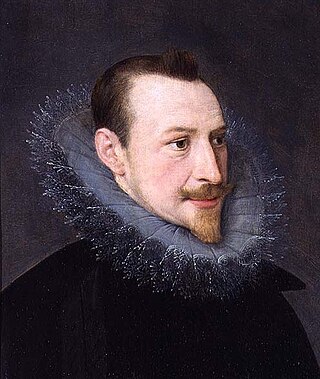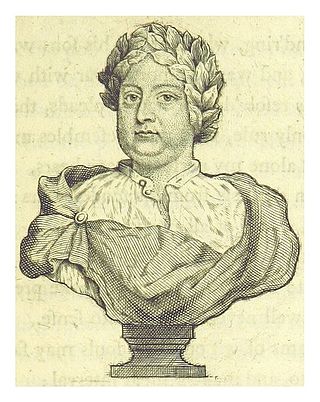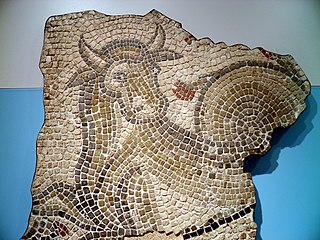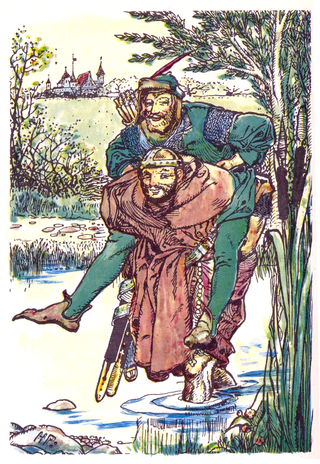
As a literary device or artistic form, an allegory is a narrative or visual representation in which a character, place, or event can be interpreted to represent a hidden meaning with moral or political significance. Authors have used allegory throughout history in all forms of art to illustrate or convey complex ideas and concepts in ways that are comprehensible or striking to its viewers, readers, or listeners.

Edmund Spenser was an English poet best known for The Faerie Queene, an epic poem and fantastical allegory celebrating the Tudor dynasty and Elizabeth I. He is recognized as one of the premier craftsmen of nascent Modern English verse and is often considered one of the greatest poets in the English language.

The Faerie Queene is an English epic poem by Edmund Spenser. Books I–III were first published in 1590, then republished in 1596 together with books IV–VI. The Faerie Queene is notable for its form: at over 36,000 lines and over 4,000 stanzas, it is one of the longest poems in the English language; it is also the work in which Spenser invented the verse form known as the Spenserian stanza. On a literal level, the poem follows several knights as a means to examine different virtues, and though the text is primarily an allegorical work, it can be read on several levels of allegory, including as praise of Queen Elizabeth I. In Spenser's "Letter of the Authors", he states that the entire epic poem is "cloudily enwrapped in Allegorical devices", and that the aim of publishing The Faerie Queene was to "fashion a gentleman or noble person in virtuous and gentle discipline".
Caelia is a Fairy Queen in Richard Johnson's romance Tom a Lincoln. Caelia is the ruler of an island called "Fairy Land," populated by women who have slain their warmongering men. She begs Tom and his companions to stay on the island so that it might be re-peopled. She eventually bears Tom's son, the Faerie Knight, but later commits suicide by drowning herself when she thinks that Tom has abandoned her.

Mac Flecknoe is a verse mock-heroic satire written by John Dryden. It is a direct attack on Thomas Shadwell, another prominent poet of the time. It opens with the lines:
Archimago is a sorcerer in The Faerie Queene by Edmund Spenser. In the narrative, he is continually engaged in deceitful magics, as when he makes a false Una to tempt the Red-Cross Knight into lust, and when this fails, conjures another image, of a squire, to deceive the knight into believing that Una was false to him.

Amoretti is a sonnet cycle written by Edmund Spenser in the 16th century. The cycle describes his courtship and eventual marriage to Elizabeth Boyle.
Diana Primrose was the author of a eulogy to the deceased Queen Elizabeth published as A Chaine of Pearle, Or a Memoriall of the peerless Graces, and Heroick Vertues of Queene Elizabeth of Glorious Memory.Composed by the Noble Lady, Diana Primrose. It is thought that this piece was written not only as a tribute to the 45-year reign of Elizabeth but as a criticism of the sometimes hot-headed King James, as well as a social criticism. The Chaine itself is made up of ten "Pearles" or short poems detailing virtues found in Elizabeth; some of these Pearles however are not qualities directly attributed to Elizabeth, and thus it is considered that they may present a criticism of the then current ruler.

Saint George and the Dragon is a book written by Margaret Hodges and illustrated by Trina Schart Hyman. Released by Little, Brown, it was the recipient of the Caldecott Medal for illustration in 1985. The text is adapted from Edmund Spenser's epic poem The Faerie Queene.

In Greek mythology, the Ophiotaurus was a creature that was part bull and part serpent. Its only known appearance in an ancient work was in Ovid's Fasti. In this poem, it was the subject of a prophecy which warned that whoever burned the innards of the Ophiotaurus would defeat the gods. Briareus attempted to burn the Ophiotaurus but was foiled by a bird sent by Zeus. This story was part of the larger Titanomachy that set the gods against the Titans. Various interpretations of the creature have been presented by scholars of classical Greece.

The American Red Cross National Headquarters is located at 430 17th Street NW in Washington, D.C. Built between 1915 and 1917, it serves both as a memorial to women who served in the American Civil War and as the headquarters building for the American Red Cross. It was declared a National Historic Landmark in 1965.

Lincoln green is the colour of dyed woollen cloth formerly originating in Lincoln, England, a major cloth town during the high Middle Ages. The dyers of Lincoln, known for colouring wool with woad to give it a strong blue shade, created the eponymous Lincoln green by overdyeing this blue wool with yellow weld or dyers' broom, Genista tinctoria. Other colours like "Coventry blue" and "Kendal green" were linked to the dyers of different English towns.

The Allegory of Faith, also known as Allegory of the Catholic Faith, is a Dutch Golden Age painting by Johannes Vermeer from about 1670–1672. It has been in the Metropolitan Museum of Art in New York since 1931.

The Palace of Pleasure is a poem by James Henry Leigh Hunt published in his 1801 collection Juvenilia. Written before he was even sixteen, the work was part of a long tradition of poets imitating Spenser. The Palace of Pleasure is an allegory based on Book II of Edmund Spenser's The Faerie Queene and describes the adventure of Sir Guyon as he is taken by airy sylphs to the palace of the "Fairy Pleasure". According to Hunt the poem "endeavours to correct the vices of the age, by showing the frightful landscape that terminates the alluring path of sinful Pleasure".

The Una and the Lion was a British £5 gold coin depicting Queen Victoria. It is recognized as one of the most beautiful British coins ever struck. It was designed by William Wyon in 1839, to commemorate the beginning of Queen Victoria's reign. The coins were first produced in 1839 and were probably intended for collector sets rather than for circulation. The production ran to a few hundred coins including a number of variations such as different metals, different hairbands on the depiction of the queen, different edge types, and a variation in the reverse inscription.

"The Mathematics of Magic" is a fantasy novella by American writers L. Sprague de Camp and Fletcher Pratt, the second story in their Harold Shea series. It was first published in the August 1940 issue of the fantasy pulp magazine Unknown. It first appeared in book form, together with the preceding novella, "The Roaring Trumpet", in the collection The Incomplete Enchanter, issued in hardcover by Henry Holt and Company in 1941, and in paperback by Pyramid Books in 1960. It has since been reprinted in various collections by numerous other publishers, including The Compleat Enchanter (1975), The Incompleat Enchanter (1979), The Complete Compleat Enchanter (1989), and The Mathematics of Magic: The Enchanter Stories of L. Sprague de Camp and Fletcher Pratt (2007). It has been translated into Dutch and Italian. In 2016, the story was shortlisted for the Retro Hugo Award for Best Novella.

Britomart Redeems Faire Amoret is an oil painting on canvas by English artist William Etty, first exhibited in 1833 and now in Tate Britain. Intended to illustrate the virtues of honour and chastity, it depicts a scene from Edmund Spenser's The Faerie Queene in which the female warrior Britomart slays the evil magician Busirane and frees his captive, the beautiful Amoret. In Spenser's original poem Amoret has been tortured and mutilated by the time of her rescue, but Etty disliked the depiction of violence and portrayed her as unharmed.

Mammon, originally exhibited as Mammon. Dedicated to his Worshippers, is an 1885 oil painting by English artist George Frederic Watts, currently in Tate Britain. One of a number of paintings by Watts in this period on the theme of the corrupting influence of wealth, Mammon shows a scene from Edmund Spenser's The Faerie Queene in which Mammon, the embodiment of greed, crushes the weak through his indifference to their plight. This reflected Watts's belief that wealth was taking the place of religion in modern society, and that this worship of riches was leading to social deterioration. The painting was one of a group of works Watts donated to the South Kensington Museum in late 1886, and in 1897 it was one of 17 Watts paintings transferred to the newly created Tate Gallery. Although rarely exhibited outside the Tate Gallery, the popularity of reproductions made Mammon one of Watts's better known paintings.
The House of Pride is a notable setting in Edmund Spenser's epic poem The Faerie Queene. The actions of cantos IV and V in Book I take place there, and readers have associated the structure with several allegories pertinent to the poem.
The Quest is a ballet score by William Walton, written for a ballet of the same title, now lost, choreographed by Frederick Ashton in 1943. Two versions of the score exist: one for the small orchestra for which Walton wrote, and a posthumously constructed version rescored for an orchestra of the larger size usually favoured by the composer. The ballet, with a scenario by Doris Langley Moore, was based on The Faerie Queene by Edmund Spenser. It was first given by the Sadler's Wells Ballet company.















